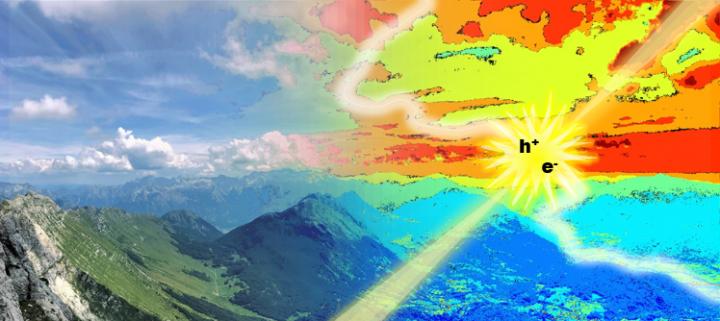Mapping the energetic landscape of solar cells

Artistic representation of an energetic landscape that determines the movement of photo-induced positive (h+) and negative (e-) charges in photovoltaic devices. Credit: Yana Vaynzof Usage Restrictions: This image may be used only in connection with the contents of this press release, and the source of the image must also be cited.
A new spectroscopic method now makes it possible to measure and visualise the energetic landscape inside solar cells based on organic materials. It was developed by a research team led by Prof. Dr Yana Vaynzof, a physicist at Heidelberg University.
This novel visualisation technique enables scientists to study the physical principles of organic photovoltaics with extreme precision and to better understand processes such as energetic losses.
“Mapping our Earth's landscapes was a necessary step for understanding the movement patterns and dynamics of people, animals and water, among other examples”, explains Prof. Vaynzof, research group leader at the Kirchhoff Institute for Physics at Heidelberg University.
“Similarly, the movement of electric charges in a solar cell is determined by the energetic landscape within the device.” Until now, visualising these energetic landscapes was so challenging that only rough estimates could be used to study the fundamental processes in organic photovoltaic devices.
The spectroscopic method developed by the Heidelberg researchers can map the energetic landscape on a nanometre scale and can be applied at any point during the solar cell's lifetime. “The strength of our method lies in its excellent resolution and great versatility”, says Vincent Lami, member of Prof. Vaynzof's team and the lead author of the study. According to Prof. Vaynzof, their work solves a key problem in the field of organic photovoltaics.
“Without mapping the energetic landscapes, it is difficult to understand how and why devices lose energy in the process of converting light into electricity. Now we have a spectroscopic method that allows us to develop new generations of solar cells with reduced energy losses and improved performance”, emphasises the scientist, who heads the “Organic Electronics” research group at the Kirchhoff Institute for Physics and works at the Centre for Advanced Materials of Heidelberg University.
###
The research is part of the ENERGYMAPS project, for which Prof. Vaynzof received funds from the European Research Council (ERC) in the form of an ERC Starting Grant. The current results were published in the journal “Joule“.
Media Contact
All latest news from the category: Physics and Astronomy
This area deals with the fundamental laws and building blocks of nature and how they interact, the properties and the behavior of matter, and research into space and time and their structures.
innovations-report provides in-depth reports and articles on subjects such as astrophysics, laser technologies, nuclear, quantum, particle and solid-state physics, nanotechnologies, planetary research and findings (Mars, Venus) and developments related to the Hubble Telescope.
Newest articles

NASA: Mystery of life’s handedness deepens
The mystery of why life uses molecules with specific orientations has deepened with a NASA-funded discovery that RNA — a key molecule thought to have potentially held the instructions for…

What are the effects of historic lithium mining on water quality?
Study reveals low levels of common contaminants but high levels of other elements in waters associated with an abandoned lithium mine. Lithium ore and mining waste from a historic lithium…

Quantum-inspired design boosts efficiency of heat-to-electricity conversion
Rice engineers take unconventional route to improving thermophotovoltaic systems. Researchers at Rice University have found a new way to improve a key element of thermophotovoltaic (TPV) systems, which convert heat…



